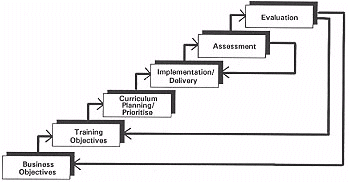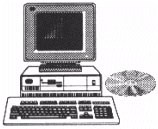[ IIMS 94 contents ]
Implementing CD-ROM training
Sean Curtin
Applied Learning, New South Wales
Multimedia training is broadly defined as the use of video, sound and graphics under computer control. In the training area, this exciting technique allows the learner to interact with the computer to select, control and pace the learning experience. Additionally, the material can be presented in a visually relevant and creative manner that can enhance the enjoyment of the learning process as well as its effectiveness.
The CD-ROM offers an effective way of delivering multimedia training. CD-ROM technology is not the only way to deliver multimedia training but this paper focuses on this exciting delivery medium. Multimedia CD-ROM training has many benefits but unless it is implemented effectively these benefits might not be realised. This paper identifies a number of important factors which should be considered for successful implementation. The CD (Compact Disk) has been a familiar way of storing music in many homes for some time. A CD-ROM (Compact Disk - Read Only Memory) is a storage device linked to a personal computer, usually with a sound device. This paper looks at some practical suggestions for implementing courseware.
Introduction to multimedia
Multimedia training is broadly defined as the use of video, sound and graphics under computer control. In the training area, this exciting technique allows the learner to interact with the computer to select, control and pace the learning experience. Additionally, the material can be presented in a visually relevant and creative manner that can enhance the enjoyment of the learning process as well as its effectiveness.
The CD-ROM offers an effective way of delivering multimedia training. CD-ROM technology is not the only way to deliver multimedia training but this paper focuses on this exciting delivery medium.
Multimedia CD-ROM training has many benefits but unless it is implemented effectively then benefits might not be realised. This paper identifies a number of important factors which should be considered for successful implementation.
What is multimedia CD-ROM training?
The CD (Compact Disk) has been a familiar way of storing music in many homes for some time. A CD-ROM (Compact Disk - Read Only Memory) is a storage device linked to a personal computer, usually with a sound device. The CD-ROM has the ability to store video, graphics, music and text. The cost of CD-ROM equipment is relatively low compared with other technologies, eg interactive video.

Benefits of self paced multimedia training
- Time to learn can be reduced
- Savings in time, cost and expenses can be very significant
- Training is always consistent
- Training is non-threatening
- Training may be done where and when it is needed
- Training can be done at the learner's own pace.
- Revision is always possible.
- Training can be highly motivational
- Experts agree that appealing to more of the learner's senses enhances attention, motivation to learn and retention of material
Training cycle

A successful training cycle has several steps. Implementation is just one of these steps.
Business objectives
In the 1990s many organisations are faced with business process re-engineering and a focus on core business activities only. This will lead to identifying the skills required by staff. The first step is to recognise your organisation's objectives and needs.
Training objectives
Your training objectives will be determined by the skills required to meet the organisation's business objectives.
Curriculum planning/prioritising
Many organisations are now trying to do "more with less". Finding time for training can be a problem and determining the curriculum to maximise "on the job performance' or competence on the job is essential. Training needs to be prioritised to ensure critical training is undertaken first and pre-requisite training takes place.
Implementation/delivery
Implementation involves:
- planning
- managerial commitment
- selecting courseware
- selecting equipment
- devising delivery approach
- considering impact of cultural change
- marketing
- integration into existing training curriculum
If your training is inadequately implemented, your business and training objectives may not be met even if all other development steps have been undertaken properly. Implementing new types of technology such as CD- ROM adds a new dimension to the training implementation process.
Assessment/evaluation
A comprehensive evaluation strategy is necessary to prove a positive impact on business performance. It ensures that what is on offer meets the job performance requirements of the staff and can be cost justified.
The importance of implementation
Successful implementation will ensure that:
- a training product is accepted
- the course objectives are met
- employees will know when the course is available, how to use the equipment and will recognise the job performance benefits to them
Some practical suggestions for implementing courseware
Planning
Once you have set your objectives you need to plan carefully taking into consideration the resources you will need to implement your training plan. These will include:
- personnel
- finance
- equipment
- timetables
- curriculum
- evaluation criteria
Commitment from management
Multimedia training requires involvement from many different departments, line managers, training personnel, information systems resources, financial analysts and employees. The likelihood of success increases if there is a commitment by senior management to the project. In making a business case for multimedia training to high level management, it is important to link your training plan to strategic goals of the company. The closer these links, the greater the impetus to sustain continued forward movement on multimedia projects.
Courseware
As the number of multimedia computers grow, so too does the volume of CD-ROM training courseware available to organisations. It is advisable to test courseware or the equipment to be used.
Equipment - Configuration
Minimum multimedia PC (MPC2) Configuration
|
| Processor | 486SX25 |
| RAM | 4 MB |
| Floppy drive | 1.44 MB |
| Hard disk | 160 MB |
| video card 1 MB | 640 x 480 x 64 kB |
| Audio - DAC | 16 bit |
| CD-ROM reader | 300 kB/s |
| Monitor | SVGA |
| Operating system | MS DOS 3.3 |
| GUI | Windows 3.1 |
| Pointing device | 2 buttons |
| This is not a complete technical listing. |

Administration
Training staff who can distribute and install course material, integrate and repair system components, prepare usage/performance reports, and answer learner questions about course use and/or content are needed to assure that learners have successful experiences on the system. Whether staff comprise internal personnel or sub-contractors, speedy and competent support is critical if multimedia learning systems are to produce the results required. Multimedia training in action should be clearly seen and easily accessible to staff who want to use it.
Considering impact of cultural change
An important consideration in any training plan is understanding the traditional learning culture of the company. What responsibility do managers and individuals take for the learning process? If self paced multimedia training has not been used before, it is important to address this in your plan by promoting its use and benefits, for example, by organising demonstrations.
Marketing
Traditionally training has not recognised a need to market itself. It has offered a range of products and whether these products and services were taken up was largely left to individual departments. In short, the training function was product or supply driven. Consequently, many training functions are still peripheral to the main business of an organisation. The products they supply do not always meet real needs and even if they do these needs are not always perceived as such by staff. The training function must become market driven, responsive to identifying and meeting its client needs.
An organisation needs the right culture to encourage training activity. It is important to market multimedia training within your own organisation. Involving employees, developing campaign themes, publicising, the benefits and what is available, sharing success stories and involving executives will help.
In summary, to exist in a commercial competitive environment training must identify needs and requirements on an on going basis, create the culture in which its product will flourish and choose the right marketing strategy.
Some suggestions for marketing training are:
- Maintain a high profile
- Presentations
- Open Days and Demonstrations
- Publicise success stories
- Advertise "specials"
- Maintain regular contact with managers
- Enlist the Managing Director's help
- Distribute enrolment forms
- Issue certificates of completion
Integration of CD-ROM training into existing training curriculum
People are still keen to interact with other learners and sometimes there is the perception that multimedia training doesn't allow for this. Multimedia training can be used as part of the overall training curriculum and where appropriate.
Clear instructions
Some people might not know how to operate the Personal Computer or CD-ROM . Wall charts showing how to operate equipment and training courses can be helpful. A telephone Helpline is another suggested backup, especially when the training is delivered outside administered Learning Centres.
Scheduling
Sometimes workloads are unrealistically high and people don't feel there is time to train. It is important that people recognise that training will take some time when setting productivity targets. Sessions of one hour to two hours duration are generally recommended.
Evaluation
It is important that evaluation of multimedia CD-ROM training forms part of your training plan. Evaluation allows you to determine if your training is working for you and whether it fits into your organisation's culture. The results will allow you to address any issues.
The achievement of lasting performance improvement requires a more sophisticated approach to the evaluation of training than currently exists in most organisations. A successful evaluation strategy has several benefits:
- It ensures a training and development activity which has a proven and positive impact on business performance.
- It ensures that what is on offer meets the job performance requirements of the staff and can be cost justified by an improvement in business performance.
- It will assess the value of the training and show a measurable improvement to stated business objectives.
- The results of the evaluation can be used to justify the current expenditure on training and to justify future training based on assessment of required staff competencies.
| Author: Mr Sean Curtin, Regional Manager, Applied Learning, 71 Epping Road, North Ryde NSW 2113. Tel: 02 887 3988 Fax: 02 887 1780.
Please cite as: Curtin, S. (1994). Implementing CD-ROM training. In C. McBeath and R. Atkinson (Eds), Proceedings of the Second International Interactive Multimedia Symposium, 114-117. Perth, Western Australia, 23-28 January. Promaco Conventions.
http://www.aset.org.au/confs/iims/1994/bc/curtin.html
|
[ IIMS 94 contents ]
[ IIMS Main ]
[ ASET home ]
This URL: http://www.aset.org.au/confs/iims/1994/bc/curtin.html
© 1994 Promaco Conventions. Reproduced by permission. Last revision: 3 Feb 2004. Editor: Roger Atkinson
Previous URL 30 Apr 2000 to 30 Sep 2002: http://cleo.murdoch.edu.au/gen/aset/confs/iims/94/bc/curtin.html




